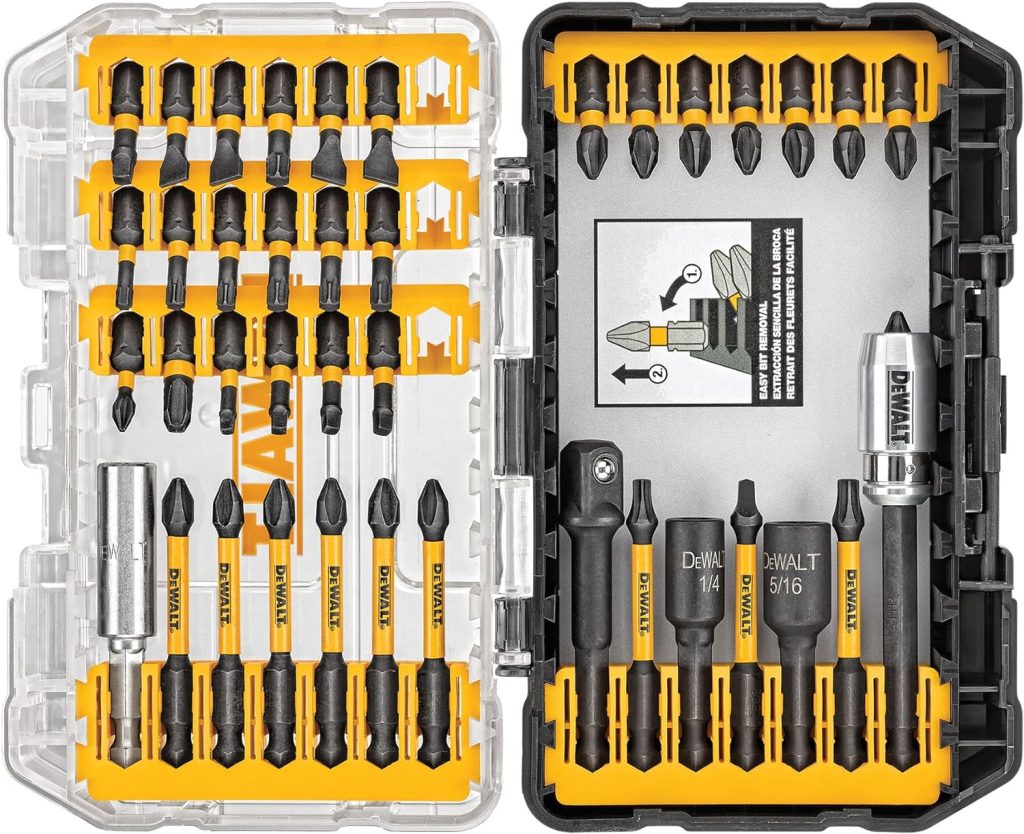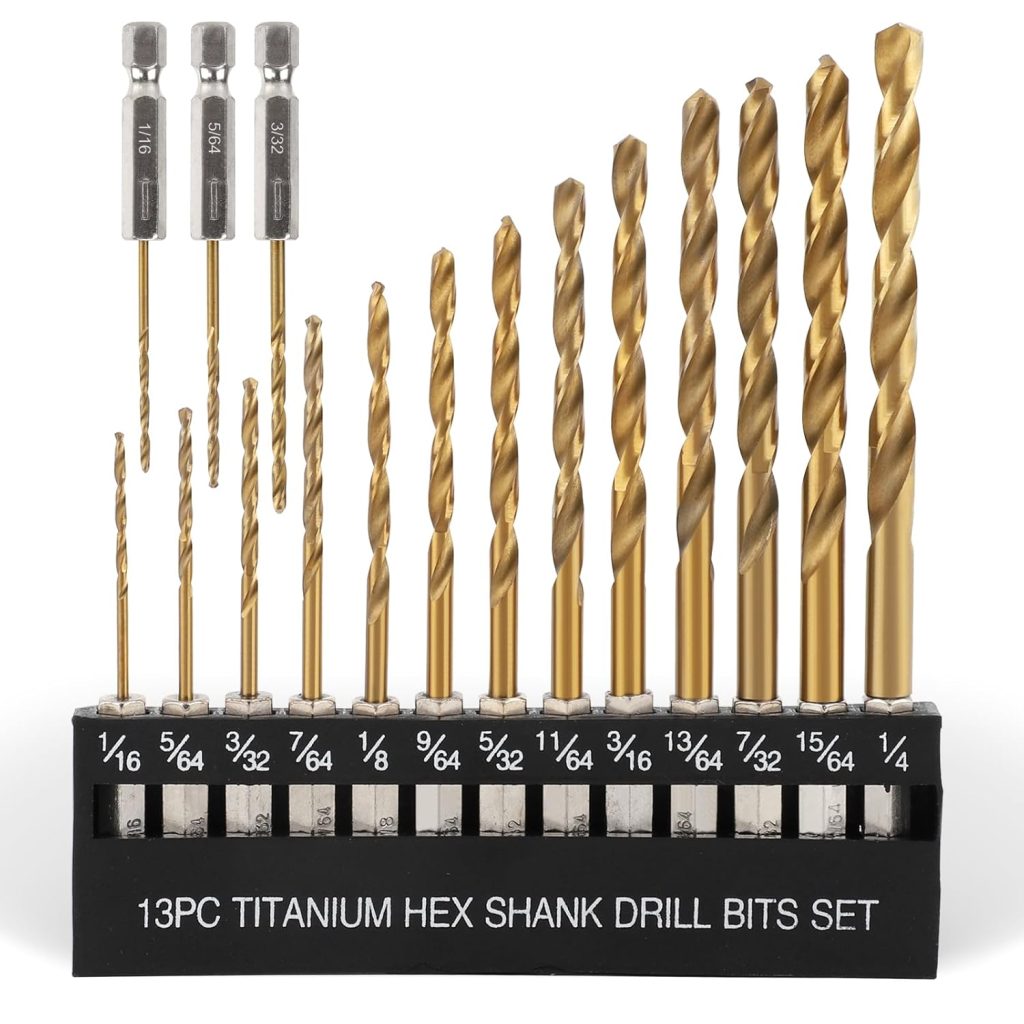Drill Bit Size Chart
How It Works:
- Select Input Type: Choose the type of drill bit size to input (fractional, metric, letter, or number).
- Enter Size: Input the size in the chosen format (e.g.,
1/4,5 mm,A, or#60). - View Results: The tool displays the equivalent size in all formats, along with suggested use.
This tool can easily be expanded for additional sizes or custom needs! Let me know if you’d like further enhancements.
Looking for the perfect fit? Check Out These Best-Selling Drill Bit.






Here is a Drill Bit Size Chart in full, covering metric and imperial drill bit sizes, including their decimal equivalents and suggested uses for materials like wood, metal, and plastic.
Full Drill Bit Size Chart
| Size Type | Nominal Size | Decimal (inches) | Decimal (mm) | Recommended Use |
|---|---|---|---|---|
| Fractional | 1/16″ | 0.0625 | 1.5875 | Fine drilling for small parts |
| 1/8″ | 0.125 | 3.175 | General-purpose drilling | |
| 1/4″ | 0.25 | 6.35 | Standard wood/metal drilling | |
| 1/2″ | 0.5 | 12.7 | Large holes in softwood/metal | |
| 3/4″ | 0.75 | 19.05 | Large holes for plumbing pipes | |
| 1″ | 1.0 | 25.4 | Very large holes | |
| Metric | 1 mm | 0.0394 | 1.0 | Precision small-hole drilling |
| 5 mm | 0.1969 | 5.0 | General-purpose use | |
| 10 mm | 0.3937 | 10.0 | Medium holes in wood/metal | |
| 20 mm | 0.7874 | 20.0 | Large holes for pipework | |
| Letter | A | 0.234 | 5.944 | Machinist drill bit |
| F | 0.257 | 6.528 | Precision holemaking | |
| Z | 0.413 | 10.49 | Larger machinist applications | |
| Number | #80 | 0.0135 | 0.343 | Small pilot holes |
| #60 | 0.04 | 1.016 | Small parts or screws | |
| #1 | 0.228 | 5.791 | Large pilot holes |
Drill Bit Size Conversion Tool
This interactive Drill Bit Size Conversion Tool allows users to input a drill bit size in any format (fractional, metric, letter, or number) and convert it into other measurement systems. It also suggests the material and purpose for each drill bit size.
Here’s a general drill bit size chart to help you choose the right drill bit for various tasks. The size of a drill bit typically refers to the diameter, and it can be measured in inches, millimeters, or gauge numbers. Below is a chart covering the most common sizes for both metric and imperial measurements:
Imperial (Inches) Drill Bit Sizes
| Fractional Size (Inches) | Decimal Equivalent (Inches) |
|---|---|
| 1/64 | 0.0156 |
| 1/32 | 0.0313 |
| 3/64 | 0.0469 |
| 1/16 | 0.0625 |
| 5/64 | 0.0781 |
| 3/32 | 0.0938 |
| 7/64 | 0.1094 |
| 1/8 | 0.1250 |
| 9/64 | 0.1406 |
| 5/32 | 0.1563 |
| 11/64 | 0.1719 |
| 3/16 | 0.1875 |
| 13/64 | 0.2031 |
| 7/32 | 0.2188 |
| 15/64 | 0.2344 |
| 1/4 | 0.2500 |
| 17/64 | 0.2656 |
| 9/32 | 0.2813 |
| 19/64 | 0.2969 |
| 5/16 | 0.3125 |
| 21/64 | 0.3281 |
| 11/32 | 0.3438 |
| 23/64 | 0.3594 |
| 3/8 | 0.3750 |
| 25/64 | 0.3906 |
| 13/32 | 0.4063 |
| 27/64 | 0.4219 |
| 7/16 | 0.4375 |
| 29/64 | 0.4531 |
| 15/32 | 0.4688 |
| 31/64 | 0.4844 |
| 1/2 | 0.5000 |
Metric (Millimeters) Drill Bit Sizes
| Metric Size (mm) | Decimal Equivalent (Inches) |
|---|---|
| 0.5 | 0.0197 |
| 1.0 | 0.0394 |
| 1.5 | 0.0591 |
| 2.0 | 0.0787 |
| 2.5 | 0.0984 |
| 3.0 | 0.1181 |
| 3.5 | 0.1378 |
| 4.0 | 0.1575 |
| 4.5 | 0.1772 |
| 5.0 | 0.1969 |
| 5.5 | 0.2165 |
| 6.0 | 0.2362 |
| 6.5 | 0.2559 |
| 7.0 | 0.2756 |
| 7.5 | 0.2953 |
| 8.0 | 0.3149 |
| 8.5 | 0.3346 |
| 9.0 | 0.3543 |
| 9.5 | 0.3740 |
| 10.0 | 0.3937 |
Numbered Gauge Sizes (Common for Thin Materials)
Gauge sizes are commonly used for drilling holes in thin materials such as sheet metal or plastic. The larger the number, the smaller the drill bit:
| Gauge | Decimal Equivalent (Inches) |
|---|---|
| 80 | 0.0135 |
| 78 | 0.0160 |
| 76 | 0.0170 |
| 74 | 0.0200 |
| 72 | 0.0230 |
| 70 | 0.0250 |
| 68 | 0.0280 |
| 66 | 0.0310 |
| 64 | 0.0330 |
| 62 | 0.0360 |
| 60 | 0.0380 |
| 58 | 0.0410 |
Choosing the Right Drill Bit Size:
- Woodworking: For wood, use bits around 1/8″, 3/16″, or 1/4″ for most tasks. Larger sizes may be needed for specific projects.
- Metalworking: Smaller bits like 1/16″ and 1/8″ work well for precise drilling in metal, but use carbide bits for tougher metals.
- Masonry: For brick, stone, or concrete, use masonry drill bits with a carbide tip, usually ranging from 1/4″ to 1/2″.
- Pilot Holes: When making pilot holes, typically use a drill bit that is about the size of the screw you will be using.
Make sure to check your project requirements, as some materials might need specialized bits (e.g., wood, metal, or masonry), and the bit size might vary based on the thickness of the material or the size of screws/nails you’re working with.
Frequently Asked Questions
1. What is a drill bit size chart?
A drill bit size chart provides the dimensions of different types of drill bits, including their diameter, length, and sometimes their shank size. It helps you identify the appropriate drill bit for specific tasks, such as drilling holes for screws, bolts, or other fasteners. The chart typically includes both metric and imperial sizes for convenience.
2. What do the numbers on a drill bit mean?
The numbers on a drill bit refer to its diameter. For example:
- A 1/8 inch drill bit has a diameter of 1/8 inch.
- A 5mm drill bit has a diameter of 5 millimeters.
In some cases, you might also see numbers like #6, #8, or #10 for drill bits, which indicate a size in a numbered system used in the United States. These sizes correspond to specific diameters, with higher numbers representing larger diameters.
3. What’s the difference between metric and imperial drill bit sizes?
- Metric sizes are based on the International System of Units (SI), where the diameter is measured in millimeters (mm).
- Imperial sizes are used mainly in the U.S. and measure the diameter in inches (in).
You’ll often find drill bits in both measurements, and many drill bit sets include both systems to offer flexibility.
4. How do I choose the right drill bit size?
The right drill bit size depends on:
- The material you’re drilling: Harder materials (like metal or concrete) require specific drill bits and sizes.
- The screw or fastener size: The drill bit needs to match the diameter of the screw or fastener to ensure a proper fit.
- Hole depth and diameter: The drill bit should be long and wide enough to create the hole you need.
5. What is the most common drill bit size?
The most common drill bit size for general-purpose use is typically 1/8 inch (3.175mm) to 1/4 inch (6.35mm). For larger holes or more specialized tasks, sizes like 1/2 inch (12.7mm) or 3/8 inch (9.525mm) are also common.
6. What size drill bit should I use for screws?
The drill bit size for screws depends on the screw gauge:
- For a #6 screw, you might use a 1/8 inch (3mm) drill bit.
- For a #8 screw, a 5/32 inch (4mm) bit might work.
- For a #10 screw, a 3/16 inch (4.76mm) bit might be appropriate.
Always check the screw manufacturer’s recommendations for the correct drill bit size.
7. What is a “pilot hole”?
A pilot hole is a small hole drilled before inserting a screw or fastener. The size of the pilot hole is typically smaller than the screw’s diameter to allow the threads of the screw to grip the material. You can find pilot hole sizes on drill bit charts or screw packaging.
8. What is the difference between twist bits and spade bits?
- Twist bits (the most common type) are used for general-purpose drilling in wood, metal, plastic, and masonry. They are available in a variety of sizes and come in both metric and imperial measurements.
- Spade bits are wider bits with a flat blade used for drilling larger holes in wood. They are often used for tasks like running wires through walls.
9. Why are drill bit sizes important?
Using the correct drill bit size ensures that:
- The hole you drill will be the right size for the fastener or fixture.
- The material is drilled efficiently without damage.
- The drill bit doesn’t overheat or wear out prematurely.
10. What drill bit size should I use for wall anchors?
For plastic or metal wall anchors, the drill bit should match the anchor size. Typically:
- For small plastic anchors, use a 1/4 inch (6.35mm) drill bit.
- For larger anchors, use a 3/8 inch (9.525mm) drill bit or larger, depending on the size of the anchor.
11. How do I convert between metric and imperial drill bit sizes?
To convert between metric and imperial sizes, you can use a drill bit size conversion chart. For example:
- 1/8 inch is approximately 3.175mm.
- 1/4 inch is approximately 6.35mm.
- 3/8 inch is approximately 9.525mm.
There are online conversion tools that make this easy to do if you need to quickly match sizes between systems.
12. Do I need a specific drill bit for different materials?
Yes, certain materials require specific drill bits:
- Wood: Standard twist drill bits or spade bits.
- Metal: High-speed steel (HSS) or cobalt drill bits.
- Concrete/Brick: Masonry drill bits, usually with a carbide tip.
- Plastic: Standard twist bits, but slow drilling speeds are often recommended.
13. What are numbered drill bits?
In addition to fractional (imperial) and metric sizes, there’s also a numbered system used in the U.S. for specific applications, especially in machining. These numbered drill bits range from #1 (0.2280 inches) to #80 (0.0135 inches), with each number representing a different size.
Conclusion
Having a solid understanding of drill bit sizes can make your DIY or professional projects go much smoother. The right size drill bit ensures precision, avoids material damage, and allows for the perfect fit for screws, anchors, or other fasteners. With a bit of planning and using a drill bit size chart, you can select the perfect bit for every job whether you’re working with wood, metal, plastic, or masonry.
If you’re ever in doubt, it’s always helpful to consult a size chart and, if needed, test drill with a smaller bit before progressing to a larger one.
More Tools






